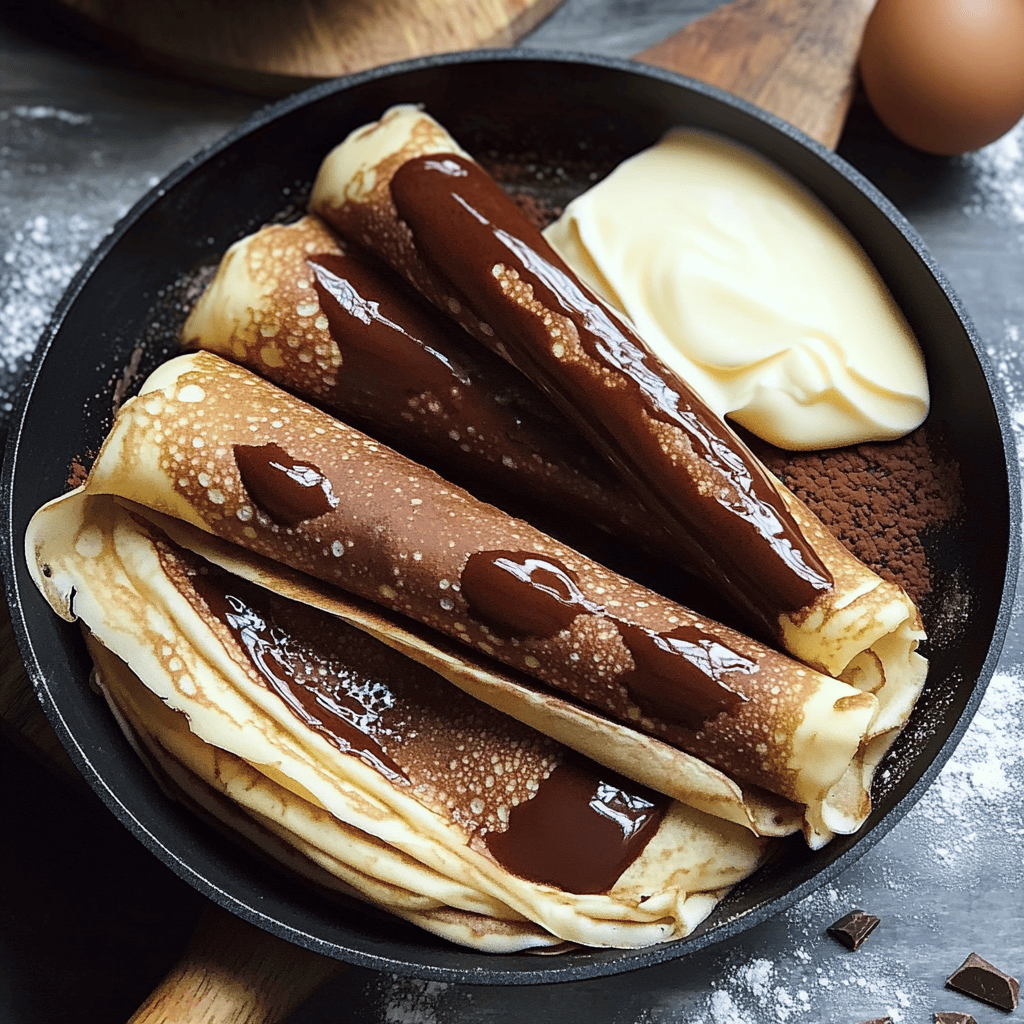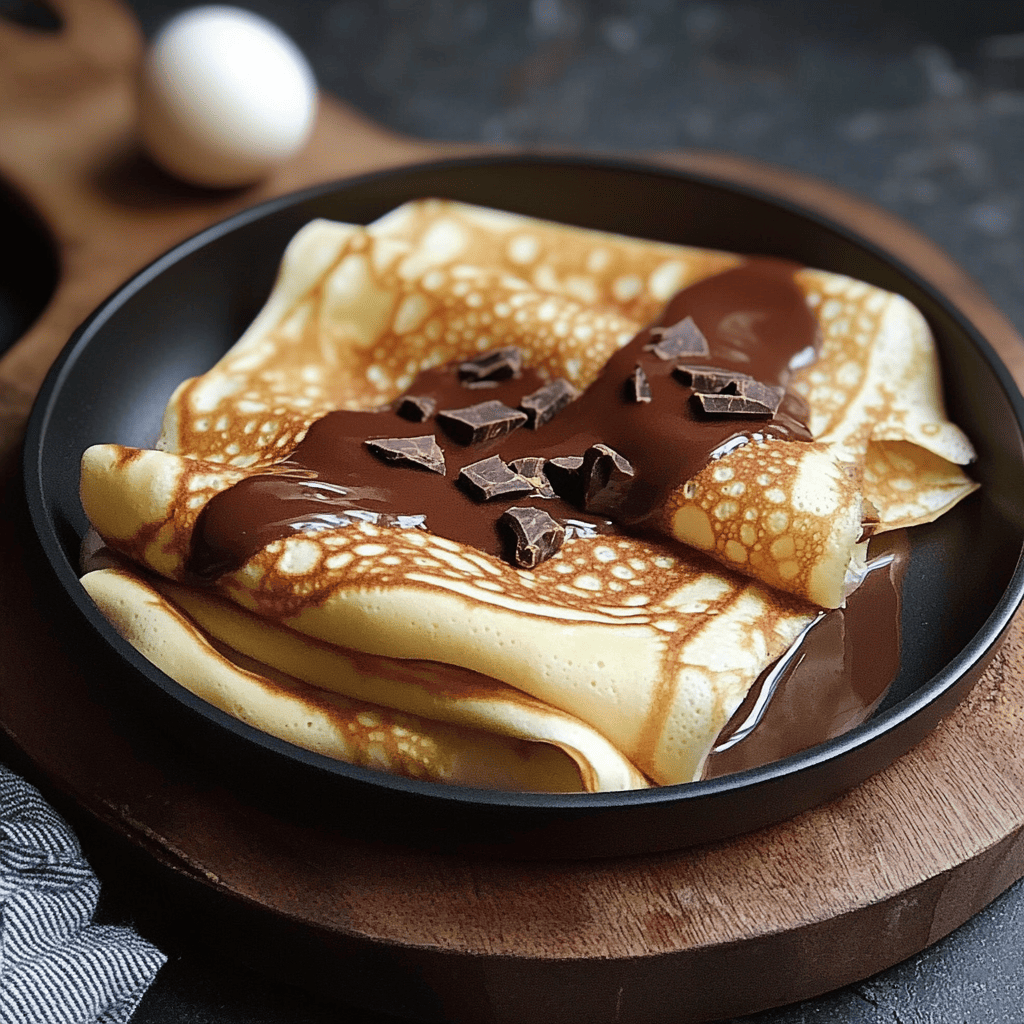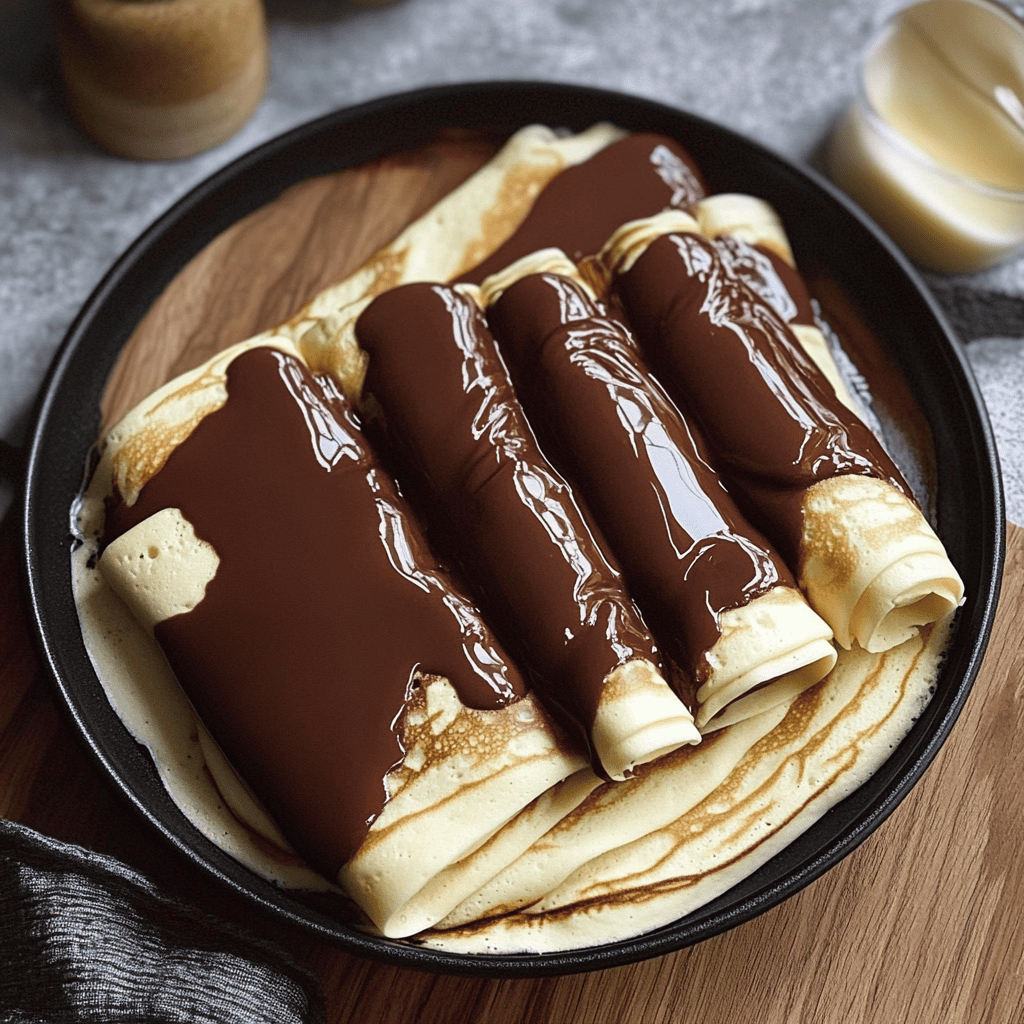Chocolate Crepes: The Sweet Embrace of Delicacy and Flavor
Introduction: A Sophisticated and Simple Classic at the Same Time
Chocolate crepes are a universally beloved dessert, combining the delicacy of thin, fluffy pancakes with the indulgent richness of chocolate. They’re incredibly versatile, ideal for breakfast, a snack, or as an elegant after-meal dessert. The beauty of crepes lies in their simplicity: a light batter that cooks quickly and lends itself to endless filling possibilities, with chocolate (especially the spreadable Nutella kind, as seen in the picture) being one of the most popular and delicious. This dish is a true delight for the senses, offering a sweet and comforting experience in every bite. Discover all the secrets of this preparation that will have you craving a plateful of them!
Detailed History in Spanish: From Peasant Origins to Global Haute Pastry
The history of crepes is as ancient as it is fascinating, with deep roots in French culinary culture and beyond.
Ancient and Breton Origins: Crepes originate in the Brittany region of northwestern France. The earliest versions are believed to date back to the 13th century, when buckwheat was introduced to the region. Originally, galettes (savory crepes) were made with buckwheat flour and were an inexpensive staple food for peasants, cooked on hot stones or flat griddles. They were a practical way to use available grains and an easy-to-prepare source of sustenance.
The Transition to Wheat and Sweetness: Over time, especially beginning in the 20th century, white wheat became more accessible and began to be used to make thinner, sweeter crepes, known simply as “crêpes” (in contrast to buckwheat “galettes”). This evolution allowed for the incorporation of sweet fillings such as sugar, jams, and, of course, chocolate.
Candlemas (La Chandeleur): In France, crepes are strongly associated with “La Chandeleur” (Candlemas Day), which is celebrated on February 2nd. Traditionally, it is said that flipping crepes with a coin in hand will bring good luck and prosperity throughout the year. This tradition reinforces the symbolism of crepes as a dish that brings joy and good fortune.
Globalization and Chocolate: The popularity of crepes spread from France to the rest of the world. Their versatility made them adaptable to different cultures and tastes. The combination with chocolate is a more recent addition, popularized largely by the availability and marketing of chocolate and hazelnut spreads (such as Nutella) beginning in the mid-20th century. Chocolate, with its universal appeal, quickly became one of the most sought-after fillings.
The Modern Presentation: The way the crepes are presented in the picture (rolled and dripping with chocolate) is one of the most popular ways to serve them today, highlighting the generous filling and the softness of the crepe. This dish, though simple in its components, is a testament to how a peasant staple can be transformed into a gourmet dessert, enjoyed in cafes and homes around the world.
More Historical Detail: The Crepe as a Vehicle of Flavors and a Symbol of Celebration
Digging a little deeper into the history of Chocolate Crepes, we can consider the following cultural influences and aspects:
- The Art of Simplicity: The perfection of a crepe lies in its simplicity: few ingredients and a cooking technique that requires practice to achieve its characteristic delicacy. This simplicity is what has allowed it to become a base for countless fillings and flavor combinations in diverse cultures.
- Crepes in Other Cultures: Although crepes are iconic in France, similar variations exist in many other cultures. For example, palatschinken in Central Europe, blinis in Russia, pancakes in Latin America (often thicker), and dosa in India. This demonstrates the universality of the idea of a flat “pancake” as food.
- Chocolate: A Universal Love: The history of chocolate dates back to Mesoamerican civilizations and arrived in Europe in the 16th century. Originally consumed as a bitter beverage, it evolved to become the sweet and luxurious ingredient we know today. Its combination with crepes was a natural progression once chocolate became more accessible as a dessert.
- Nutella and the Postwar Era: The popularization of chocolate spreads, such as Nutella (created in Italy in the 1940s and 1960s), played a crucial role in the widespread use of chocolate crepes. These spreads offered a delicious, affordable, and convenient way to fill crepes, making the dessert even more accessible and popular.
- Versatile Dessert: Crepes aren’t just limited to sweet desserts. They can be a main course in their savory version (galettes), filled with ham, cheese, egg, mushrooms, etc., which underscores their incredible versatility in French cuisine.
The Chocolate Crepe, therefore, is not just a dessert, but a small piece of culinary history that celebrates the adaptability, simplicity, and universal pleasure of chocolate.

Ingredients & Detailed Preparation
Ingredients (for 8-10 medium crepes):
For the crepe batter:
- Large eggs: 2 units
- Whole milk: 1 cup (240 ml)
- All-purpose wheat flour: 1 cup (120 g)
- Sugar: 2 tablespoons (optional, for sweet crepes)
- Melted butter (unsalted): 2 tablespoons (30 g), plus extra for greasing the pan
- Vanilla extract: 1 teaspoon (optional)
- A pinch of salt
For the filling and decoration:
- Chocolate and hazelnut spread (Nutella type): Generous amount
- Powdered sugar (for dusting, optional)
- Fresh fruits (strawberries, banana, raspberries, optional)
- Whipped cream (optional)
Detailed Preparation:
A. Prepare the Crepe Batter:
- Mixing Liquids: In a large bowl, beat the eggs. Add the milk and vanilla extract (if using) and mix well.
- Stir in dry ingredients: Using a whisk, gradually add the flour, sugar, and a pinch of salt to the wet mixture. Beat until smooth and the batter is complete. It’s important to beat well to avoid lumps.
- Add the butter: Add the melted butter to the batter and mix until well combined.
- Batter Rest (very important): Cover the bowl with plastic wrap and refrigerate the batter for at least 30 minutes, or ideally 1 hour. This allows the gluten in the flour to relax, resulting in more tender crepes that are less likely to break. It also allows the flour to absorb liquids better, improving the final texture.
B. Cook the Crepes:
- Heat the pan: Heat a nonstick pan about 20-25 cm in diameter (ideally a crepe maker) over medium heat. It’s crucial that the pan is piping hot.
- Grease the pan: Lightly grease the pan with a little butter (you can use a piece of butter on a paper towel or nonstick spray). Wipe off any excess.
- Pour the batter: Using a ladle, pour about 1/4 cup of batter into the center of the hot pan. Immediately tilt and swirl the pan to spread the batter evenly over the entire surface, forming a very thin layer.
- Cook the first side: Cook for 1-2 minutes, or until the edges of the crepe are lightly browned and the surface looks dry with small bubbles.
- Flip the crepe: Using a thin, flexible spatula, carefully flip the crepe. Cook the second side for another 30-60 seconds, or until lightly browned.
- Remove and stack: Remove the cooked crepe from the pan and place it on a plate. Continue cooking the remaining batter, lightly greasing the pan between each crepe if necessary. Stack the cooked crepes to keep them warm and soft.
C. Fill and Serve:
- Fill with chocolate: Spread a generous amount of chocolate and hazelnut spread (Nutella type) over half of each crepe.
- Roll: Fold the crepe in half and then roll it from the folded edge to the other end, as shown in the picture, creating a tight roll.
- Garnish (optional): For presentation purposes, you can drizzle a little more melted chocolate over the rolled crepes and/or sprinkle with powdered sugar. If using fruit, place it on the side or inside the crepe.
- Serving: Serve the chocolate crepes immediately, while they are warm.
Estimated Preparation Time
- Dough preparation: 10-15 minutes
- Dough Rest: 30 minutes to 1 hour (or more)
- Cooking time for crepes: 20-30 minutes (depending on quantity and speed)
- Filling and assembly: 5-10 minutes
- Total time: Approximately 1 hour and 5 minutes – 1 hour and 55 minutes
Additional Tips
- Batter consistency: The batter should be very thin, similar to heavy cream. If it’s too thick, the crepes will be thick; if it’s too thin, they’ll break. Adjust by adding a little more milk or flour if necessary.
- Ideal pan: A flat-bottomed nonstick pan is crucial. If you have a crepe maker, even better.
- First test: The first crepe often doesn’t turn out perfectly. Use this as a “test” to adjust the pan temperature and batter quantity.
- Storing crepes: Cooked crepes can be stored in the refrigerator, covered with plastic wrap, for up to 2-3 days. They can be gently reheated in a pan or microwave.
- Freezing: You can freeze cooked crepes, sandwiching baking paper between each one. Defrost in the refrigerator and reheat.
- Variety of fillings: While chocolate is delicious, crepes are incredibly versatile. Try:
- Jams and fruit compotes.
- Whipped cream and fresh fruit.
- Cream cheese and fruits.
- Caramel sauce or dulce de leche.
- Peanut or almond butter.
- Frozen.

Frequently Asked Questions
- Can I prepare the batter in advance? Yes, the batter can be prepared up to 24 hours in advance and stored in the refrigerator. This even improves the texture of the crepes. Just stir well before using.
- What should I do if the crepes stick? Make sure the pan is very hot and lightly greased for each crepe. If the problem persists, the batter may be too thick or the pan may not be nonstick enough.
- Can I make savory crepes with this batter? Yes, you can use this same batter for savory crepes, just omit the sugar and vanilla.
- What temperature should the pan be? It should be medium. If it’s too cold, the crepes will take longer to cook and turn pale; if it’s too hot, they’ll burn quickly.
Texture and Flavor
The texture of the crepes is delicate and soft, almost melting in the mouth. They are supple and tender, yet with a slight springiness that makes them perfect for rolling. The image shows a lightly golden outer layer with the characteristic browned spots. The chocolate filling is creamy and smooth, adding a dimension of softness to the already tender texture of the crepe.
The flavor is a harmonious combination of sweetness and richness. The crepe itself has a subtle flavor of egg, milk, and a hint of sweetness. The star is the chocolate, which provides an intense, sweet, and slightly bitter flavor, depending on the type of chocolate used. When chocolate and hazelnut spreads are used, a toasted note and a more pronounced sweetness are added. It is a comforting, indulgent dessert that satisfies a sweet craving without being overly heavy.
Consumer Context
Chocolate crepes are incredibly versatile and can be enjoyed on many occasions:
- Breakfast or Brunch: A special weekend breakfast.
- Snack: A sweet treat for mid-afternoon.
- Dessert: An elegant and delicious ending to any meal.
- Special Events: Ideal for parties, birthdays, or celebrations, especially if set up at a crepe station with various fillings.
- Edible gift: They can be a nice detail to bring to a meeting.
Visual Aspect
The dish is visually very appealing, as seen in the image. The rolled crepes display a pale golden color with slightly darker spots from baking. The rich, creamy chocolate filling peeks out from the edges, creating a tempting display. The lines of melted chocolate decorating the top add a touch of sophistication and a color contrast. The presentation on a dark plate makes the light colors of the crepes and the dark brown of the chocolate stand out even more. It’s a dessert that looks as delicious as it tastes.
Curiosities
- Crepes Suzette: One of the most famous crepes is the “Crepes Suzette,” a French dessert flambéed with a sauce of butter, sugar, orange juice, and liqueur (usually Grand Marnier).
- Global versatility: The crepe’s popularity has transcended borders, adapting to local tastes with different types of flour, fillings, and sauces.
- The crepe maker: At French markets and festivals, it is common to see expert crepe makers cooking crepes at high speed on large circular griddles, turning them expertly.
Nutritional Value (Estimated per Serving – 1 Crepe with Chocolate Filling)
Please note that these values are approximate and may vary significantly depending on the size of the crepe, the amount of chocolate filling, and the exact ingredients used.
- Calories: 200-350 kcal
- Protein: 5-8 g
- Fat: 10-20 g (mainly from chocolate, butter and egg yolks)
- Saturated fat: 5-10 g
- Carbohydrates: 20-35 g (from sugar, flour and chocolate)
- Sugars: 15-25 g
- Fiber: 1-2 g
- Sodium: Variable (from salt in dough)
Additional Benefits and Interesting Facts
- Quick Energy: The simple carbohydrates in the crepe and the sugar in the chocolate provide an energy boost.
- Calcium: The milk in the dough provides calcium for bone health.
- Iron: Chocolate (especially dark chocolate) contains some iron and antioxidants.
- Flexibility: The recipe is very flexible and allows for adaptations for different diets (e.g. plant-based milk, gluten-free flours).
- Fun Activity: Making crepes can be a fun cooking activity to do with your family.
Other Information
- Storing pre-filled crepes: Pre-filled crepes with chocolate are best enjoyed immediately. Leftovers may soften the crepe’s texture or harden the chocolate in the refrigerator.
- Pairing: Pairs well with a latte, hot chocolate, or a sweet dessert wine such as Port or Banyuls.

Conclusion: A Touch of French Elegance on Your Table
Chocolate crepes are a dessert that transcends cultures and generations. Their delicacy, versatility, and irresistible combination with chocolate make them a dish that’s always welcome. From their humble origins in Brittany to their current status as a global classic, the crepe reminds us that sometimes the greatest pleasures are found in simplicity and the ability to transform a few ingredients into something truly magical. Go ahead and make them and share the joy of this sweet treat!

